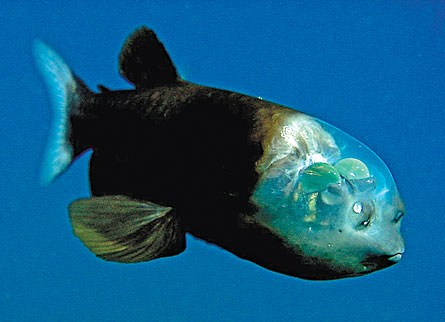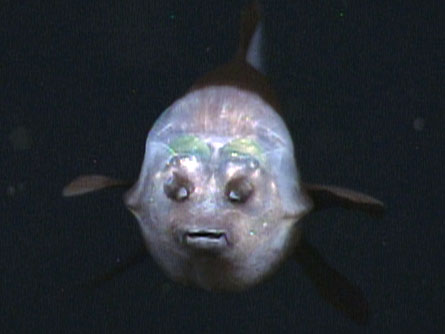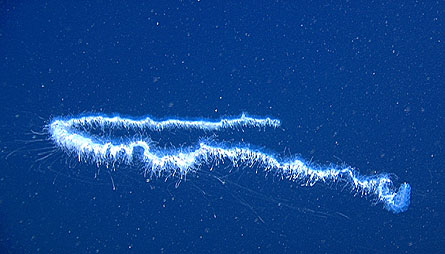Fish needs see-through head
Barreleye peers out at the world like a fighter pilot does through a windshield
 |
|
View Video | This small, dark barreleye fish has a see-through forehead. The two spots on the front of its face are nostril-like organs, not eyes. For eyes, look inside the clear covering to the pair of green domes. Those are the lenses, and this fish is looking straight up through the top of its head.
|
| © 2004 MBARI |
The fish in the picture is alive and you’re looking inside its head. Really. It’s not a medical freak. Just a kind of fish with a naturally see-through forehead.
A new species, you might think. But no. The story is odder than that.
Meet one of the fish called barreleyes. This kind lives some 600 meters deep or more (that’s more than a third of a mile) in the Pacific Ocean.
A see-through forehead sounds like something you might remember to mention when describing a new fish. But 70 years ago scientists didn’t say a word about it when they gave the fish its official scientific name (Macropinna microstoma).
Those earlier fish scientists probably didn’t know about the clear forehead. They had to work from fish caught in deep nets and dragged up to the surface. The long trip up didn’t leave the samples in such good shape.
Today a scientist can send cameras and other equipment down to study deep-sea creatures where they live. Since 1993, cameras from the Monterey Bay Aquarium Research Institute in California have met these bizarre barreleyes three times in deep water off the coast.
And researchers managed to catch one and bring it to the surface in much better shape than usual.
What a difference meeting a live fish makes. Old reports had talked about some slime on the front of the fish. Now researchers see that the slime was probably the remains of the clear forehead.
The covering is tough and like the clear canopy on a fighter jet that lets the pilot see what’s happening, says Monterey Bay scientist Bruce Robison. In the fish, the rounded window is full of clear liquid and covers the eyes.
Like fighter pilots, these barreleye fish look out through their clear covering. Check the picture for the pair of fat, green domes like the tops of balls, inside the head. Those are the lenses of the fish’s eyes. (In the picture, the green lenses point up, and the fish is looking overhead.)
Each lens sits on top of a short, wide tube, which is the rest of the eye. That’s where the name barreleye came from, and that’s an odd shape for an eye. We hope this won’t happen, but if your eyeball fell out of your head, it would look like a ball. If it were All Planet Drop An Eyeball Day, there would be lots of balls. Cats, dogs, mice, elephants and lots of other animals have round eyes.
 |
|
A front view of a type of barreleye shows its two nostril-like spots above the small mouth. The glow on the fish comes from the lights of a nearby camera vehicle. A glimmer of green inside the glowing clear forehead shows where the eye lenses are.
|
| © 2006 MBARI |
On barreleyes’ short tubes, the part that catches the image is at the bottom. That arrangement had puzzled scientists because tubular eyes should see only what’s straight in front of them and not much at the sides. That’s not very convenient. It would be a bit like looking at the world through the tube from a roll of toilet paper.
But looking at a living specimen, the researchers realized that an eye tube can move. Barreleyes point it upright to look overhead and then swing the lens downward so the tube points straight ahead, like the barrel of a mini cannon.
When the eyes point forward, the fish looks toward its pouty little mouth. Its lips stick out a bit, as if they would be good for picking morsels of food out of small places.
 |
|
A siphonophore, a long string of filmy sea creatures, swims through the water (front end to the right) snagging food in its stinging tentacles. Researchers now wonder if the clear-headed barreleye fish steals food from siphonophores. The barreleye’s clear forehead would protect the fish’s eyes from stinging tentacles.
|
| © 2001 MBARI |
What these barreleyes may do is steal food from creatures called siphonophores (sigh-FAH-nuh-4s), say the Monterey Bay scientists. Siphonophores in the area look like long, skinny, ultrafrizzy scarves made of bits of pale, soft film. Don’t wrap one around your neck though — they sting.
But the scientists think the barreleye might not care about the stings. Its clear forehead protects its eyes. So its mouth could nip off bits of prey that the siphonophores get tangled in their frizz. A clear forehead may actually be like fish goggles.
Power Words: (loosely adapted from Yahoo! Kids Dictionary, which is also the American Heritage® Dictionary of the English Language, Fourth Edition)
canopy: a covering
lens: A clear part of the eye that bends the light passing through it so light rays hit the proper place for forming a picture.
siphonophores: sea creatures with clear, filmy bodies and stinging cells that band together in floating colonies. Famous example: the Portuguese man-of-war.







